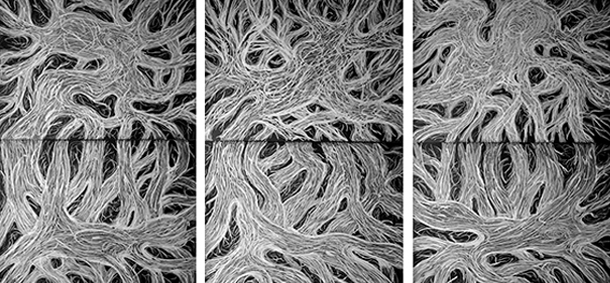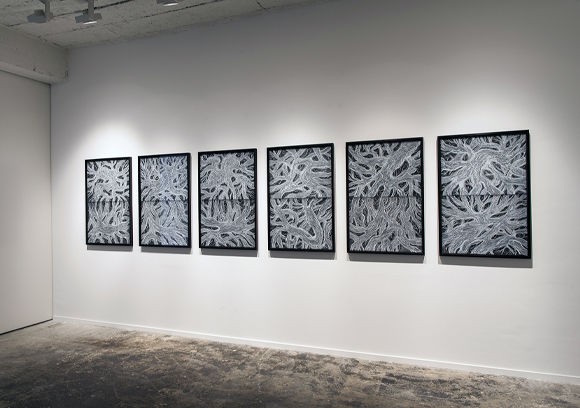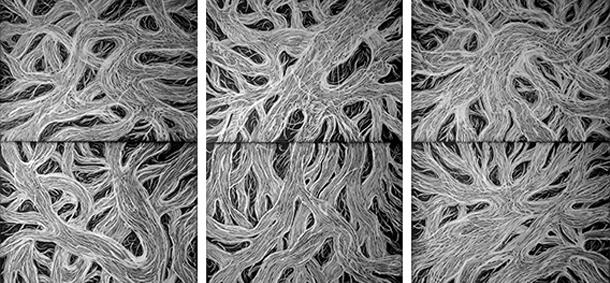| |
|
|
10.
| The Savage Mind |
| |


2016, Pastel, white pencil on paper, 99,5 x 65 cm.
Exhibition view from A Savage Mind, Keitelman Gallery, 2016, Brussels.
Courtesy of the artist and Ceysson & Bénétière, Paris.
'' Intimate and fragile, this series of drawings with their primitive aesthetic brings us back to the beginning of the artist’s work.''
Anti-utopias, January 2017

The Savage Mind
Exhibition view from A Savage Mind, Keitelman Gallery, 2016, Brussels.
Courtesy of the artist and Ceysson & Bénétière, Paris.

The Savage Mind
Exhibition view from Keeping Faith - Keeping Drawing, Analix Forever, 2019, Geneva.
Courtesy of the artist and Ceysson & Bénétière, Paris.

The Savage Mind
Exhibition view from Keeping Faith - Keeping Drawing, Analix Forever, 2019, Geneva.
Courtesy of the artist and Ceysson & Bénétière, Paris.

2016, Pastel, white pencil on paper, 99,5 x 65 cm.
Exhibition view from A Savage Mind, Keitelman Gallery, 2016, Brussels.
Courtesy of the artist and Ceysson & Bénétière, Paris.
|
|
|
|
|
|
The Savage Mind est une série aux pastels secs et gras blanc sur feuille noire par mounir fatmi. Cette série de 6 panneaux fonctionne sans discontinuité rappelant des racines et des neurones composant un réseau infini. Deux esthétiques divergentes se confondent dans cette série de dessin. Celle brute, de la simplicité relevant du dessin d’enfant libre et sans contraintes ; et d’autre part, en s’approchant, le spectateur pourra se rendre compte de la délicatesse des détails et de la complexité de ses formes, rapprochant cette série du dessin scientifiques. Ce traitement en noir et blanc induit un effet de négatif à l’image qui, produisant un effet presque cinétique, captive. Irrémédiablement attiré par cette composition vibrante, le spectateur peut alors chercher un début et une fin à cette série représentant une sorte de cartographie mentale.
En effet, cette série de dessin se relève d’une complexité qui s’explique par divers liens que l’on retrouve dans ce tissage d’inspirations divers. On retrouve ainsi certaines formes rappelant l’ornementation typique de tradition arabo-musulmane mais aussi la technique du all-over. On peut aussi percevoir dans l’utilisation de cette technique, l’influence de l’expressionnisme abstrait et du dripping de Jackson Pollock. Cette figure iconique de l’art américain à laquelle mounir fatmi a déjà rendu hommage avec sa série Rencontres (2010), mais aussi ses grandes sculptures de câbles Connexion (1999) exposées au Musée des Arts Décoratifs à Paris.
La complexité de la composition formelle de ses dessins fonctionne comme un piège visuel pour le spectateur offrant un espace de réflexion, une carte mentale. En revenant au dessin, mounir fatmi joue aussi sur cette notion de racine et de flux nerveux. Ainsi, cette série ouvre sur la question de l’identité même si ce que mounir fatmi offre à la vue de tous est bien une figuration des échanges nerveux.
Studio Fatmi, Decembre 2016.
|
|
The Savage Mind is a series of dry, bold and white pastels on black paper by mounir fatmi. This series of six panels flows without interruption and is evocative of roots and neurons composing an infinite network. Two divergent aesthetics blend in this series of drawings. Raw and simple like a child’s drawing, it is free of constraints. On the contrary, when moving closer to the piece, the spectator becomes aware of the delicacy of the details and the complexity of the forms that bring this series close to scientific drawing. The black and white element creates the effect of a negative which produces a captivating, almost kinetic effect. Irremediably attracted by this vibrant composition representing a form of mental mapping, the spectator can look for a beginning and an end of this series.
In fact, this series of drawings rises from a complexity that is explained by various ties found in the weaving of diverse inspirations. As a result, we find certain forms reminiscent of ornamentation typical of Arab-Muslim tradition, but also of the “all-over” technique. In the use of this technique, we can also find the influence of the abstract expressionism and dripping method of Jackson Pollock. mounir fatmi has paid homage to this iconic figure in American art with his series Rencontres (2010) as well as with his large sculptures composed of cables in his Connexion (1999) series exhibited at the Museum of Decorative Arts in Paris.
The complexity of the formal composition of his drawings acts as a visual trap for the spectator, offering a space for reflection, or a mental map. Returning to the drawing, mounir fatmi also plays on this notion of roots and the nervous system. Thus, this series explores the question of identity even if what mounir fatmi offers to everyone’s eye is indeed a portrayal of transmissions within the nervous system.
Studio Fatmi, December 2016.
|
|
|
|